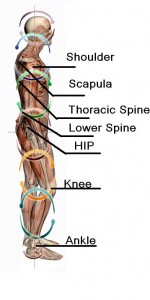 If you have a traumatic injury resulting from one occurance/accident or an over-use injury from multiple repetitions of the same motion, understanding the body’s Mobility-Stability model is crucial for a full recovery. Treating the area of pain may make you feel better, but it will probably not get you better.
If you have a traumatic injury resulting from one occurance/accident or an over-use injury from multiple repetitions of the same motion, understanding the body’s Mobility-Stability model is crucial for a full recovery. Treating the area of pain may make you feel better, but it will probably not get you better.
Each joint in your body is built to move, but some are designed to be more mobile while others function to be more stable. There is a pattern in the human body where a stable joint will have a mobile joint above and below.
The knee joint is considered a stable joint. That is, you can bend and straighten your knee, but it is not designed to rotate or move side to side. The ankle below the knee, combined with the joint between your heel and ankle bone (the Subtalar Joint) and the hip joint above the knee are designed to be very mobile. If you have a tight calf muscle that does not allow your ankle to bend or you feet have high arches that result in less heel motion, then the knee joint now has to change from being a stabile joint to more of a mobile joint leading to increased stress in the knee. In the the hip above, having tight hamstring, hip flexors or hip rotator muscles again can also to knee pain.
Another stable joint combination is the low back and pelvis. Your bottom seven vertebra combined are only built to rotate 15 to 18 degrees out of the over 45 degrees that is considered normal trunk rotation. The majority of your trunk rotation comes from your mid-back, thoracic spine region. If you have poor posture with your shoulders positioned forward, then you limit mid-back rotation and make the low back to do a job that it is not built to do, leading to pain and breakdown. The pelvis is made up of three bones, but the sacroiliac joints of the pelvis are not meant to move. If your hips joints are tight from increased sitting, driving or disuse, then your body looks to the sacroiliac joint to now become a mobile joint also leading to back and sometimes leg pain.
Strengthening your stable joints, low back, pelvis, knee is important, but it is critical that the mobile joints have the motion to do their jobs first. Occasionally, what might look like a stability problem, could actually be a mobility dysfunction and vice versa. Additionally, we know that tight muscles on one side of a joint can lead to weak muscle on the other side.
So a complete functional evaluation determining all the areas in your body that need to be corrected, will help lead to a full and successful long term recovery.

